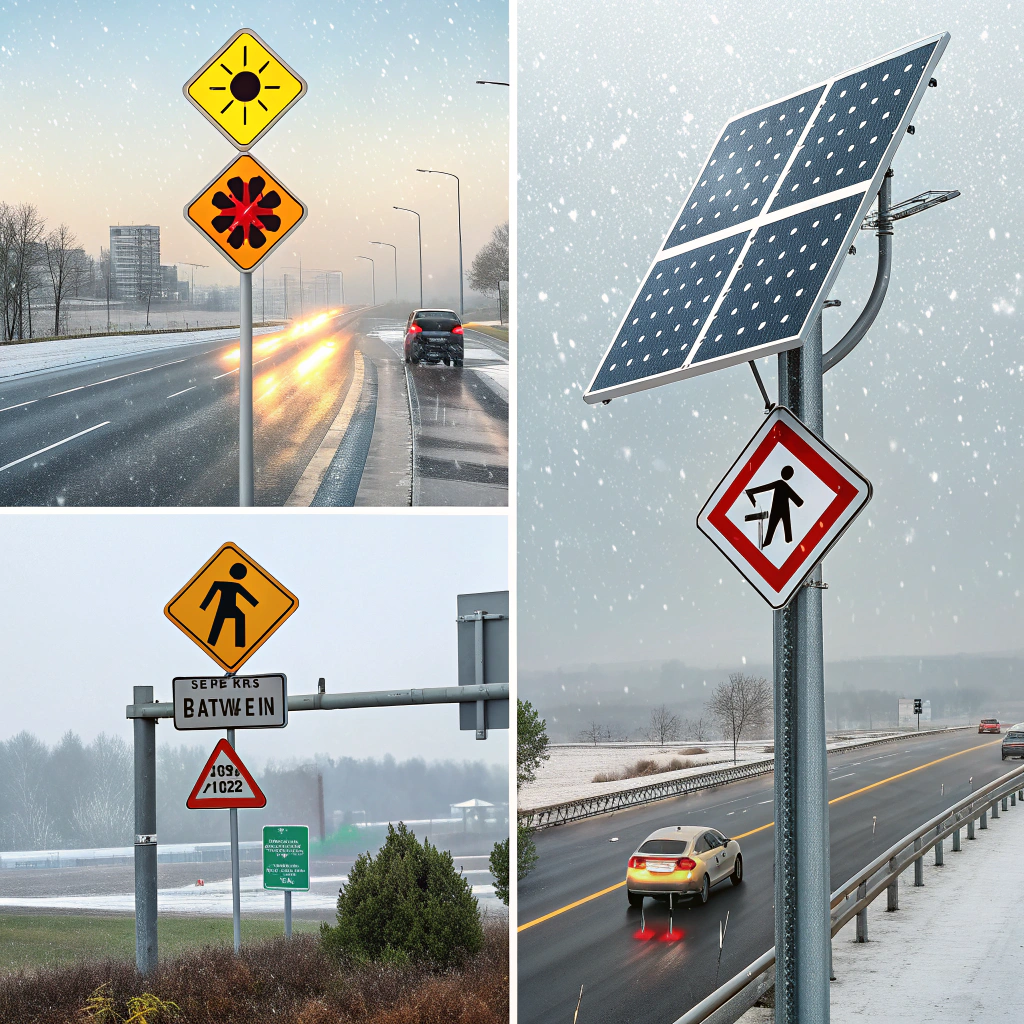Analysis of Key Technologies and Performance of Solar-Powered Traffic Signs
•
Analysis of Key Technologies and Performance of Solar-Powered Traffic Signs
Are solar-powered traffic signs the future of smart road infrastructure? These innovative signs combine renewable energy with advanced technology to create safer, more efficient roadways.
Solar-powered traffic signs use photovoltaic panels[^1] and energy storage systems to operate independently of the grid, providing reliable visibility day and night while reducing energy costs and environmental impact.

As cities worldwide push for sustainable infrastructure[^2], solar traffic signs have emerged as a smart solution. But what makes them truly effective? Let's examine the core technologies that determine their performance.
The Impact of PV Panel Conversion Efficiency on the Continuous Operation of Traffic Signs
Why do some solar traffic signs fail during cloudy periods while others maintain consistent operation? The answer lies in their photovoltaic panel efficiency.
High-efficiency PV panels[^3] (20%+ conversion rate) can generate sufficient power even in low-light conditions, ensuring traffic signs remain operational during extended cloudy weather or winter months.
Understanding PV Panel Performance Factors
The continuous operation of solar traffic signs depends on three critical panel characteristics:
-
Cell Technology
- Monocrystalline: 20-22% efficiency (best for limited space)
- Polycrystalline: 15-17% efficiency (more affordable)
- Thin-film: 10-13% efficiency (flexible but less durable)
-
- 30-45° tilt maximizes energy capture in most latitudes
- Adjustable brackets improve seasonal performance
-
Cleaning Requirements
- Dust accumulation can reduce output by 25%
- Self-cleaning coatings add 5-8% to system cost but maintain performance
| Panel Type | Efficiency | Cost per Watt | Lifespan |
|---|---|---|---|
| Monocrystalline | 20-22% | $0.35 | 25+ years |
| Polycrystalline | 15-17% | $0.28 | 20-25 years |
| Thin-film | 10-13% | $0.20 | 10-15 years |
For critical applications like highway signage, the additional investment in high-efficiency monocrystalline panels typically pays off through reliable operation and reduced maintenance.
Battery Life and Capacity: How to Ensure Long-Term Nighttime Lighting
What happens when the sun goes down? The battery system becomes the lifeline of solar traffic signs.
Deep-cycle lithium batteries[^5] (100-200Ah capacity) provide 3-5 days of backup power, while advanced charge controllers prevent over-discharge that can permanently damage battery cells.
Battery Technology Comparison
Modern solar signs use three main battery types, each with distinct advantages:
-
Lithium Iron Phosphate (LiFePO4)
- 2000+ charge cycles
- 95% depth of discharge capability
- -20°C to 60°C operating range
-
Absorbent Glass Mat (AGM)
- 500-800 charge cycles
- 50% recommended discharge depth
- Half the cost of lithium
-
Gel Cell
- 400-600 charge cycles
- Vibration resistant
- Best for extreme temperatures
Critical Consideration: The battery capacity must account for:
- LED power consumption (typically 5-20W)
- Local winter sunlight hours
- Minimum 3-day autonomy requirement
Advanced systems now incorporate battery health monitoring that alerts maintenance teams when capacity drops below 80% of original specification.
Protection Level (IP) and Material Selection: The Key to Coping with Complex Road Environments
How do solar traffic signs survive decades of weather abuse while maintaining visibility?
IP65-rated aluminum enclosures[^6] with polycarbonate lenses provide complete dust protection and resistance to low-pressure water jets, while anodized aluminum frames prevent corrosion in coastal environments.
Material Specifications for Different Environments
| Component | Urban Setting | Coastal Area | Extreme Cold |
|---|---|---|---|
| Housing Material | Powder-coated steel | 316 stainless steel | Heavy-duty aluminum |
| Lens Material | 5mm polycarbonate | 6mm polycarbonate | Heated glass option |
| Mounting System | Anti-vandal bolts | Galvanized brackets | Deep frost-proof footings |
| IP Rating | IP54 (splash proof) | IP66 (heavy rain) | IP67 (submersion) |
Special considerations include:
- UV-stabilized materials prevent yellowing
- Gorilla glass options[^7] for high-vandalism areas
- Heating elements for snow-prone regions ($120-200 additional cost)
The most durable systems combine these material choices with modular designs that allow component replacement without full sign replacement.
Conclusion
Solar-powered traffic signs deliver reliable performance through optimized PV panels, robust battery systems, and weather-resistant materials, creating sustainable infrastructure[^2] that reduces long-term maintenance costs.
[^1]: Understanding photovoltaic panels is crucial for grasping how solar-powered traffic signs operate efficiently.
[^2]: Explore the concept of sustainable infrastructure and its significance in modern urban planning.
[^3]: Explore the advantages of high-efficiency PV panels to see why they are essential for reliable solar traffic signs.




